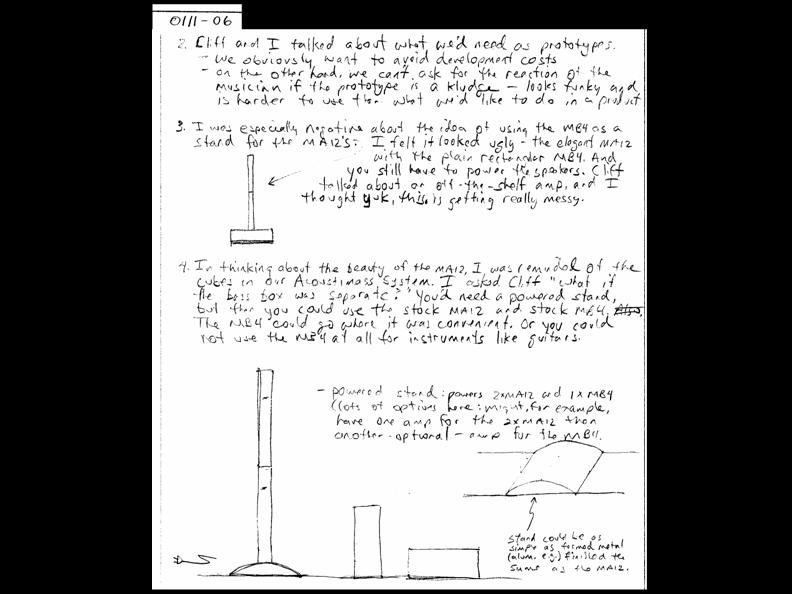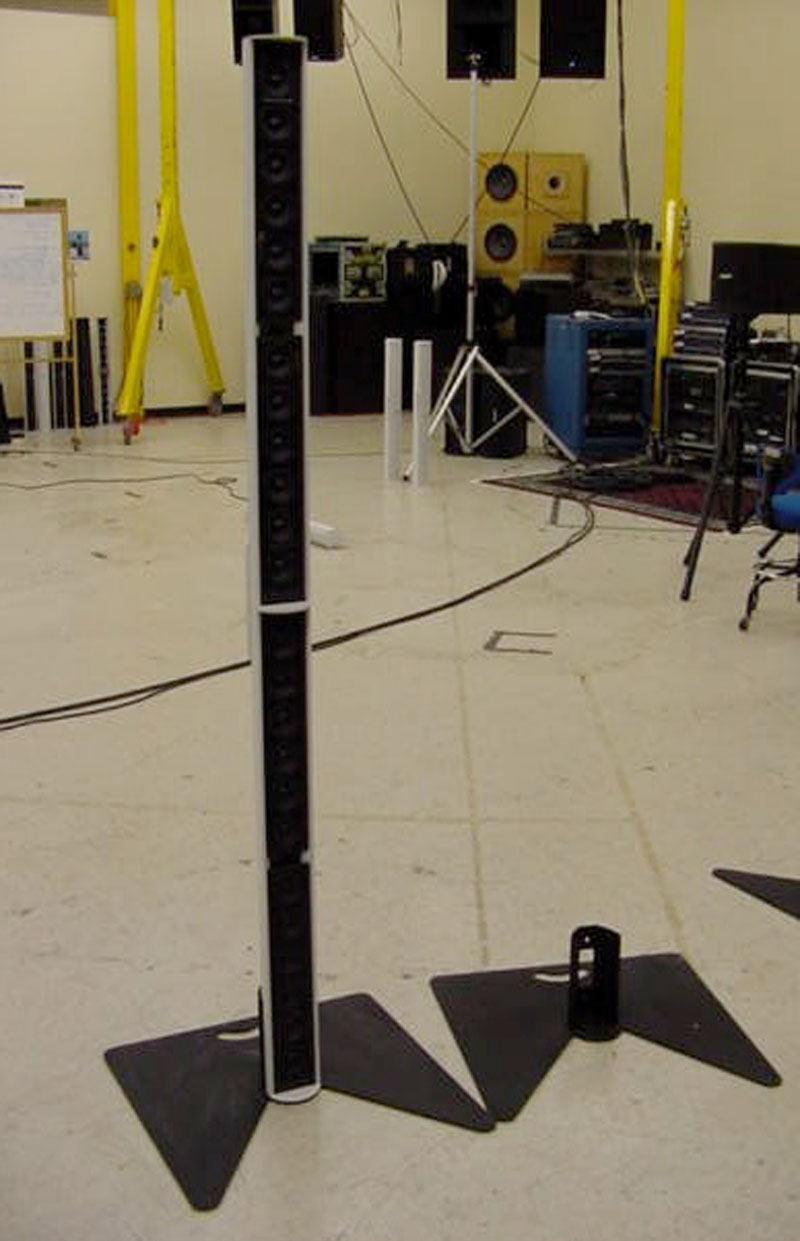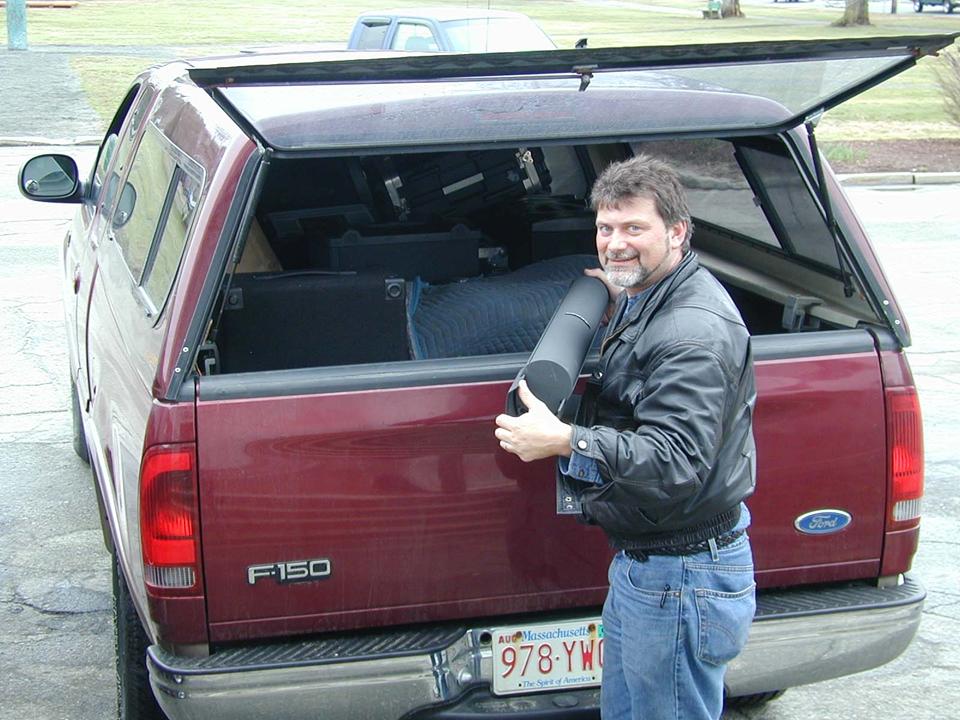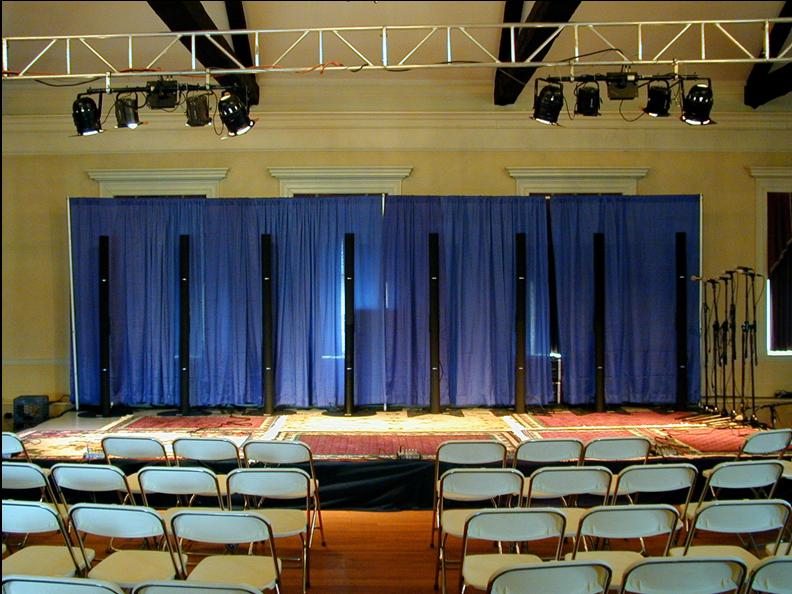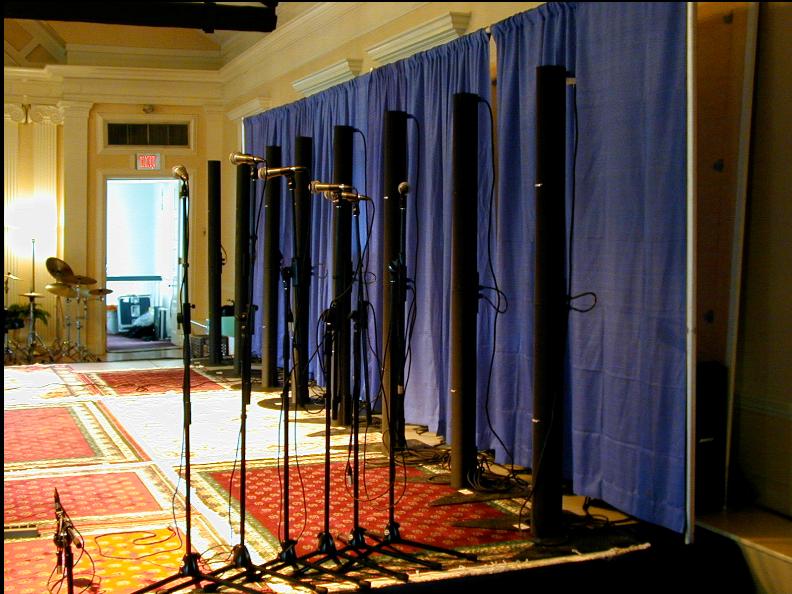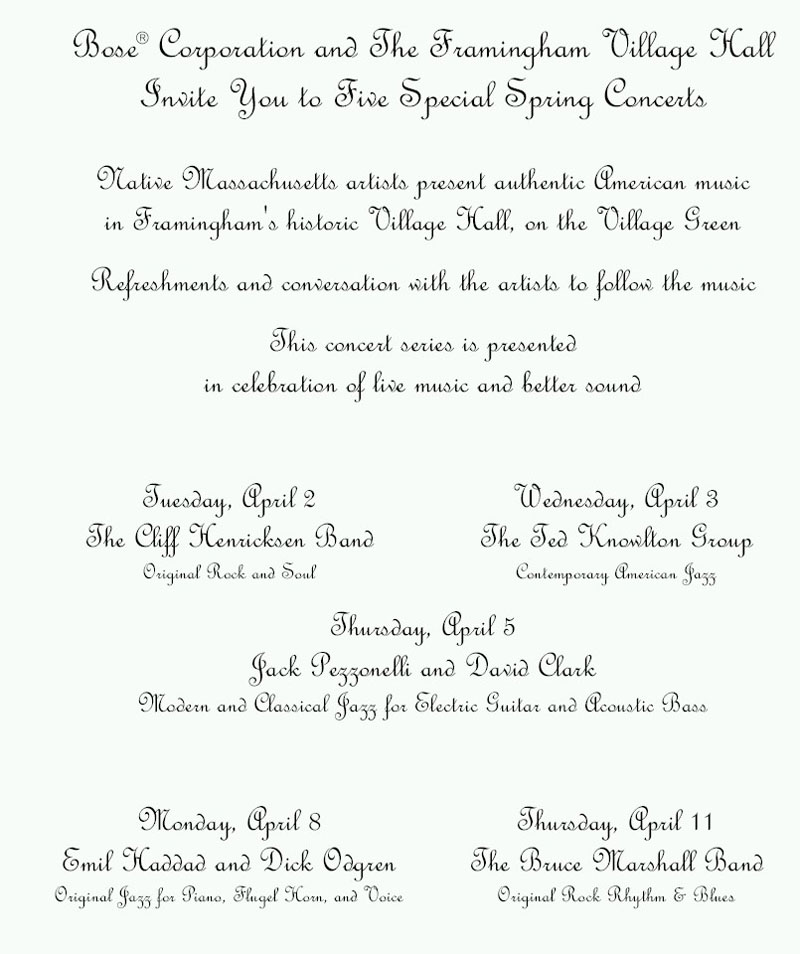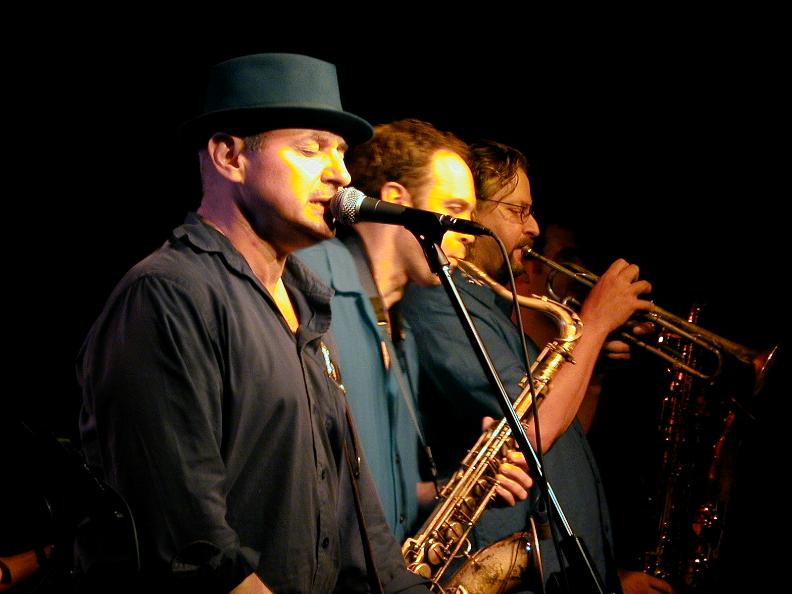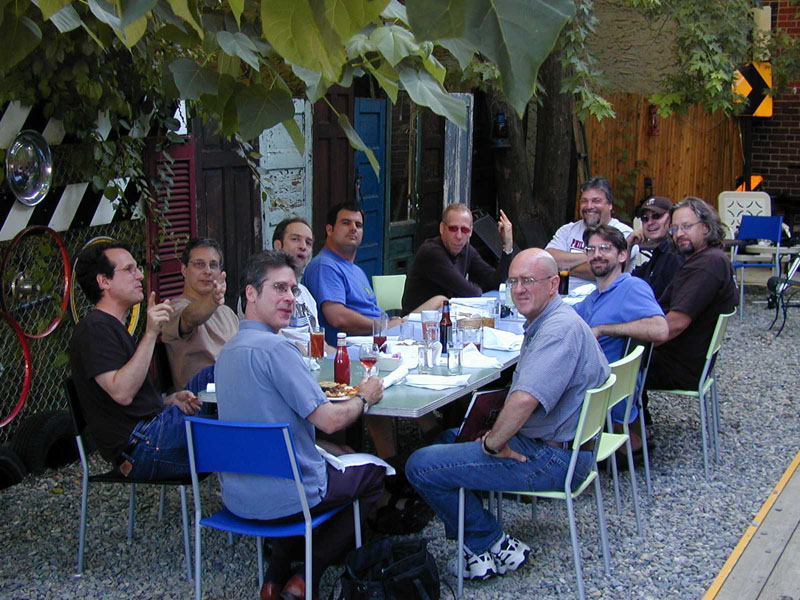Testing Our 2nd Generation Prototype
Cliff and Joe had built a number of prototypes of what was to become the L1 speaker -- the Cylindrical Radiator speaker -- and Cliff has talked about those in another post.
In late 2001 and early 2002 we decided to build another, more sophisticated prototype based on everything we'd learned.
Cliff fabricated stands for what had already become the Bose MA12 line array for installed applications. We built small racks that housed LabGruppen power amps and a DSP controller where we could dial in EQ etc.
We used Bose MB4 bass boxes.
As you can see from this notebook entry, this is where we decided to go with a separate bass box -- a momentous decision.
Here's a photo of what we ended up with.
For the first time, I felt we had something that was really starting to look elegant and truly unique -- as unique as the invention.
We built about eight of these 2nd generation prototypes and made them so they could be easily transported.
This is a shot of one of our speaker engineers who had loaded up his pickup truck with ALL of the prototype systems!!!
Even Cliff and I were amazed.
NO MONITORS!!!
NO PA!!!
NO BACKLINE AMPS!!!
NO MIXERS!!!
NO INTERCONNECTIONS!!!
OR SPEAKER STANDS!!!
And so on. Well, you know this.
I remember going to grab my camera and saying "Pete! Wait!" And taking the picture.
(By the way, Pete is a fine, fine drummer.)
We did many, many live concert tests with this set of 2nd generation prototypes.
They were roughly broken into two categories:
1. Same venue, lots of different bands.
2. Same band, lots of different venues.
For the first category, we did a series of concerts in the Spring of 2002.
What's amazing to me is that we were only 18 months from launching a commercial product in October of 2003 and we were still working with prototypes.
We chose the historic Village Hall in Framingham to do our tests for category 1 above.
It's a challenging room, fitting a few hundred when full. It's very reverberant. We chose it for several reasons.
- It was close, only about 5 minutes from our offices.
- It was typical of the places people play.
- It was acoustically challenging: if the prototypes were successful in Village Hall they'd be successful in the better behaved halls.
- We could keep the testing relatively quiet.
So we set up our "soldiers of sound" on a stage we rented, as you can see.
We put the bass boxes behind the curtain.
If you look hard you can also see the "baby mixers" that were part of the prototype systems
Here's another shot of the stage.
We wanted to show the fact that for the first time in a long time the stage was super neat.
You could really see the musicians and they could really see their audiences.
It was really, really cool.
Here's a copy of the advertisement we put in the local newspaper.
This was really tricky to pull off.
On the one hand, we were intent of doing a set of real world tests -- to be absolutely certain that our beliefs and claims could be realized. We wanted not just to prove that musicians liked the sound, but that audiences did too.
We wanted to prove that the L1 concept meant better live music. And so we had to have real concerts.
On the other hand, we wanted desperately to keep our work quiet. It would be terrible for news to leak out of our work.
This was a very difficult balancing act to pull off.
As you can see there was no mention of new technology being used. Just a celebration of live music and better sound.
That last photo, our first full protoype system ("The Soldiers of Sonic Love") would allow pretty much any amplified ensemble to plug in and play. We figured if it works here (Village Hall, the Temple of Sonic Doom), it will work anywhere. We tried all kinds of bands and acts and all the cats loved it. The ones that especially loved it and took to it the best were the jazz players, who are more used to hearing each other and playing together. Least adaptable were rock musicians who are used to playing in a monitor bubble and not playing with the whole band. Two systems were powered by half of a rack with a quad power amp and a pair of crossovers. Out front, we had 8 individual Behringer mini-mixers so the players could run their own show. Interestingly, these were not too different in size and function from the current T1, um with the exception of ToneMatch™ and a truckload of amazing signal processing. These worked great. Later, we bought a bunch of Symetrix 1/3-octave equalizers and I adjusted instrument and voice tone by ear for the players, the forerunner of ToneMatch™. I still do this work with the same units, by ear.
These days, it was just Ken and I and the occasional hired crew. We rented trucks, pipe and drape, schlepped all the gear, made all the arrangements and communications (like the above) and assembled and repaired stuff in my garage, about a half mile from Village Hall.
I have a great affection for this photo. I look at it like a diner would look at a fabulous meal set out for them. In Village Hall, the system worked great and made a huge impact on reverberation by not lighting up the hall’s upper reaches. But it made my instruments so responsive and so much more able to engage any audience that I ever experienced. The sound wrapped around me, like a hug from someone who loves me, and then went out to the audience to do the same. So in this photo, I see a place with a means of making beautiful music. Just plug in and play. I can still remember how it felt and how it sounded. It’s a really beautiful memory for me.
Ken and I decided to take a road trip to Philly where I still had a bunch of musical buddies from when we lived in this area. I played in these Philly/So Jersey clubs and music halls mostly with a band called the “Allstars” and most of them were still there, active as musicians. We invited Tony Sarno to join us, after the Guitar Summit, to play at this great club recommended by bassist Rick Prince called “North By Northwest”. We basically rented the club for the day and invited a bunch of local musicians and music-biz people (booking agents, studio and record people, promoters, etc) to tell them what we were up to. Ken did an evolving version of “Music is Human” to explain what we would be doing onstage. Then the band played. It was a great lineup, including Allstars Rick Prince (bass), Rick Valenti (harp and sings like butta), Jay Davidson (sax, later to play with Cinderella, the “Standing In the Shadows of Motown” tour and with Steve Winwood), Fred “The Red” Berman on drums (hated the Roland snare, now touring with Amos Lee), Doug DeHays (bari) and Steve Jankowski (trumpet). I played keys, happily. It was a very successful event.
Ken and I rented a big white van and trucked/schlepped all the proto gear from Framingham, probably the most cost-effective way to do it. “Others” flew, but Ken and I had a gut-splitting carnival of comedy (and Fritos) all the way up and back. We love road trips and got a chance to spend a lot of serious funtime together. What a great and funny memory.
After the event, back at "the hotel", Ken invited Tony to be a Bose employee, basically a "resident artist". His growing ability to play genuine electric guitar through the L1 (and endless stream of different ways of getting guitar tone) and front the soon-to-be-called "Linemen" band would be his basic work at Bose. He would be a musician-to-musician spokesman for the L1 and for the company, especially as he could provide advice and authentic opinions about a real recording artist's experience with the system. Tony accepted and did this work for 2years, finally leaving the corporate world to get back to being a fulltime musician again.
Ken and I knew more than ever that the only way to truly teach what the L1 was capable of was to have a real band playing through it. So, once Tony relocated to the Framingham area, he and I started recruiting local players for the band. We first met with bassist Wolf Ginandes, who I knew and had played some with. Wolf in turn (Wolf knows "everybody") brought Marty Richards into the band as drummer. (Marty really didn't like the Roland kit, but, like a pro, he said "I'll play them if you want me to". So we asked him what he really wanted to play and we got it for him: A really nice 2-tom kit with pretty cymbals and a pretty quiet output we could amplify if we wanted. This was our last use of the Vdrums and we still have our "house kit" onstage in our Live Music Theater.) Tony knew local saxman Bruce "the Goose" McGrath from previous bands they were in together, and Goose brought trumpet great "Doc" Channonhouse. Last, Cliff "Goodsy" Goodwin came along on the multiple advice of Pete Premo and Wolf as second guitarist. His work as music director for Joe Cocker made him the perfect candidate for MD for this band, and Wolf came up with the name "linemen". (Need a name for your band? Call Wolf. He has an infinite number of them that he makes up with evil glee. Tony, Goodsy Wolf and Marty later did L1 demonstrations as a 2-guitar rock and roll band. The name? Wolfy came up with "Possum Club" and it stuck. He's got some pretty funny ones and can probably just sit and spout of an endless stream of them all day long).
In the photo, that's Tony singing, Jay saxing and Steve trumpeting.
Here's the boyz having dinner in the side courtyard at NXNW, before the show. Starting far left at the table and working around clockwise: Ken (pointing up), Rick Prince (pointing at the camera), Jay Davidson, Doug DeHays (I think), Fred the Red (testing wind direction), Rick Valenti, Tony, Steve Jankowski, not sure, me and Tim Jordan, a local guitarist, singer and songwriter. Rick P and Tim are in a band together as of this writing.
